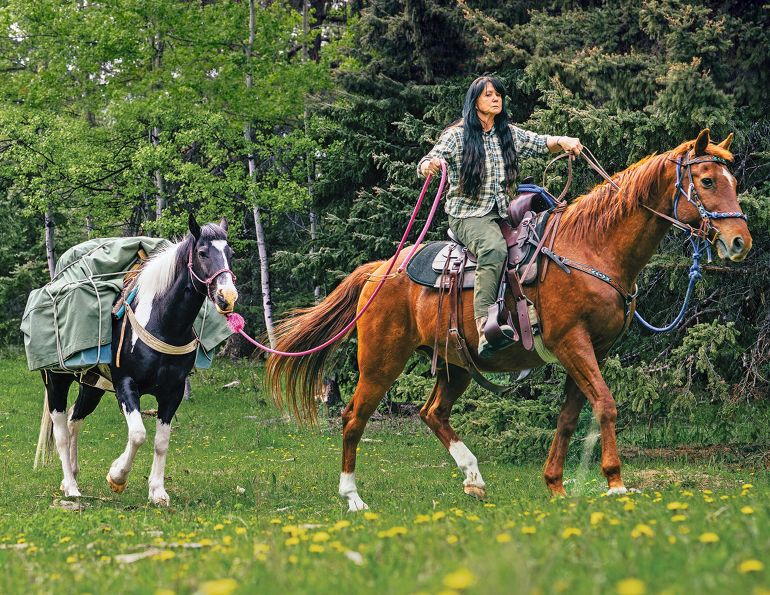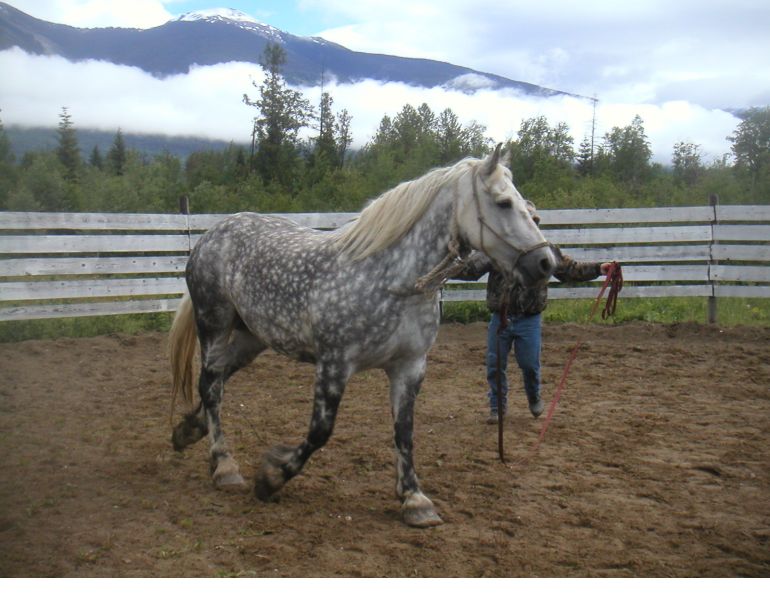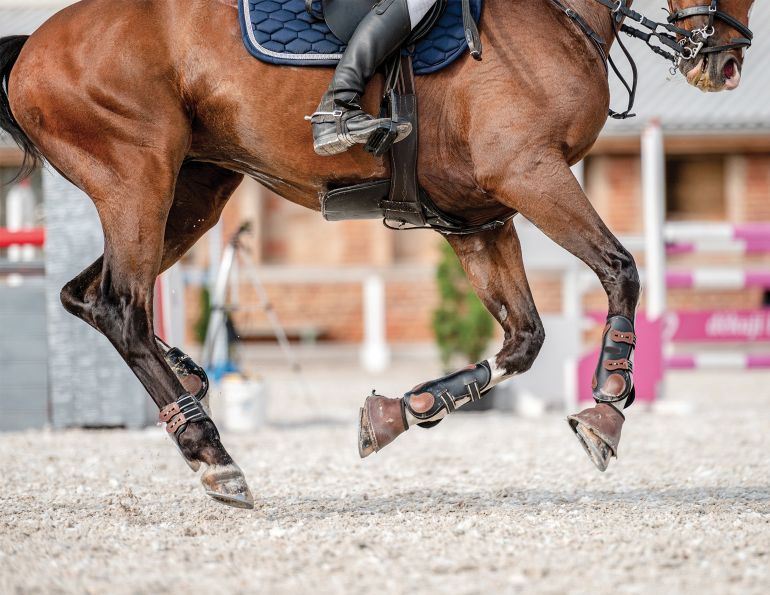By Stan Walchuk, Jr.
This article is the second in a two part series about equine first aid for the trail and home. In Part 1 of the series, we focused on vital signs, first response, care of wounds, and home remedies. In this article we’ll be looking at what to do if your horse comes up lame, sustains a head injury, suffers rope burns or saddle rubs, or comes down with the flu while you’re out on the trail.
In the event of a serious injury or illness, you should always seek veterinary attention if a vet is available. However, when you’re out on the trail, it is important to have a thorough understanding of how to treat common injuries or illnesses until they can be seen to by a vet.
Lameness
If your horse begins to limp when you are riding along a trail, the cause of the limp is a mild, temporary bruise or sprain, similar to stubbing your toe or slightly twisting your ankle. Within a couple of minutes or a few hundred meters, the limp should wear off. However, if the limp is pronounced or does not disappear within several minutes, you need to get off and examine the foot and leg for a stone lodged under the shoe or in the sole, a wound, a puncture, a sprain, or another injury.
A loose or tossed shoe can also produce lameness-like symptoms. You may be able to re-tighten the nails on a loose shoe with simple tools; if not, walk rather than ride the horse back to where it can be re-shod. On longer journeys with horses that have a good solid hoof wall, we will pull the remaining shoe, trim the feet but leave enough hoof wall for the trail, and continue to ride barefoot, always conscious of the condition of the bare feet.
Because we ride through all kinds of rugged terrain with stone covered, brush choked trails, it is not uncommon to find a foot or leg with a scrape, bruise, or small cut. I always feel better if I do find a minor injury as it eliminates the possibility of a serious sprain or other damage like a pulled tendon, navicular, laminitis, etc. There is no point in treating a small wound before getting to camp or back to your vehicle, as the topical will simply wear off or wash off.
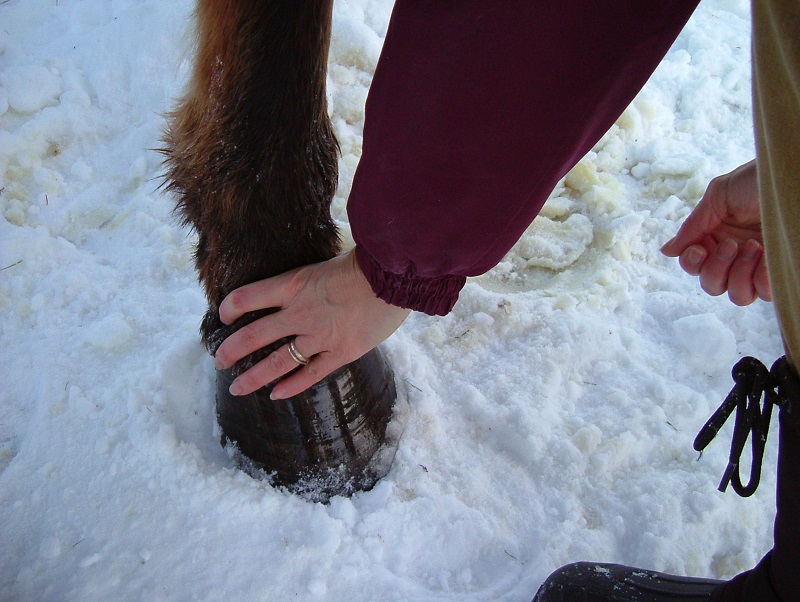
Carefully examine the hoof and leg for swelling, heat, cuts, scrapes, and punctures. Photo: Stan Walchuk, Jr.
If you cannot determine the cause of the limp and it is pronounced, you need to perform a closer examination and reduce the movement of, and weight borne by, the horse. You can usually detect a sprain by the presence of heat and swelling, the horse’s sensitivity to pressure, and the stance of the horse. Touching the coronet band and ankle area of both the healthy foot and the injured foot will help you to detect heat or swelling in the injured area. If you firmly squeeze the ankle, pastern, or coronet band in the area of injury, the horse will often react by pulling its foot away or lifting its head. Don’t be alarmed if your trail horse stands at rest with the back leg slightly lifted; this is a normal resting position. However, it is not normal for a horse to stand with a front leg lifted, or a toe pointed; this is an indication of an injury.
If there is no obvious wound or indication of a sprain, then take a good look at the sole of the hoof for a puncture or badly bruised sole. Clean the hoof well before examining it, as punctures small in diameter can be hard to see but are very serious due to the possibility of the horse contracting tetanus. If you do find a puncture, it needs to be cleaned, disinfected as deeply as possible, packed and wrapped, and the horse must be walked out to where it can be examined by a vet. On longer trips we often carry penicillin and always use it for horses with puncture wounds. If there is no puncture or visible damage, you can press on specific areas of the sole very firmly with your thumb or a blunt thumb-sized object to check for tender areas that might indicate a bruised sole.
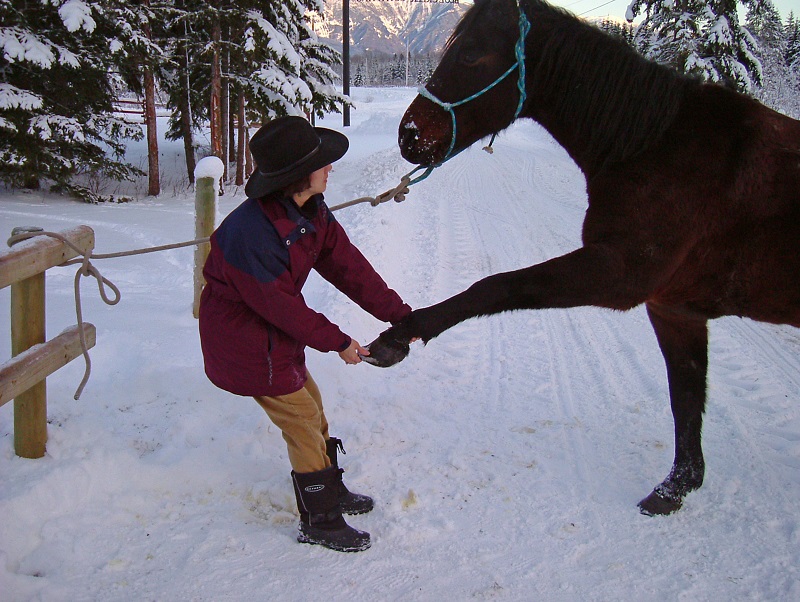
If you suspect a shoulder injury, stretch the hoof and leg forward and watch for the horse’s reaction to determine if there is an injury. The horse should never be tied while you are performing this test. Photo: Stan Walchuk, Jr.
If no lower leg injuries can be found, then I get really worried as shoulder injuries from extended tendons do not have a good prognosis. Thirty years and a hundred horses in our trail string later, I still think about ‘Red,’ a big, bay Morgan/Percheron cross who was completely reliable and infallible, or so I thought, until he unexpectedly came up with a limp from a shoulder injury. Even after a year of rest he favoured that shoulder after an easy ride, and another two years didn’t change anything. Very sadly, he could no longer be ridden. You can check for a shoulder injury by stretching the foot and leg forward and upward. If an injury is present in the shoulder, the horse will react by lifting its head up and back. The horse should never be tied when you do this.
There are other reasons a horse may come up lame on the trail, such as founder and laminitis, but in the case of any lameness you need to restrict movement and reduce the weight carried by the horse. If we are on a long journey and a horse comes up with a pronounced lameness, we make plans around the injury, meaning we make camp in the closest possible site. It doesn’t have to be a great campsite, just one that will allow the horse to have a few days off.
If lameness strikes on the trail far from your home or trailer, and you suspect an ankle sprain (probably the most common cause of a limp on the trail), stand the injured leg in water, the colder the better. The cool water will help minimize heat and swelling.
Your next move should be to immobilize the leg with a tensor bandage. At times I have split kindling and used a wooden splint along the sides of the bandage to further reduce movement. It is very important that the bandage not be wrapped too tightly, as reduced circulation can cause further damage.
Once you have cooled the leg and immobilized it with a bandage, then, if home or the trailer is within reasonable walking distance, walk rather than ride out to reduce the amount of weight on the injured leg.
The time to really worry about lameness is when the limp is pronounced and there are no external signs of injury. Sometimes a sprain does not swell markedly and diagnosis is difficult. In any event, a vet needs to be called as soon as you get home, as there are a host of possible causes for lameness including laminitis, tendon issues, navicular, shin splints, ringbone, and other serious maladies.
It bears repeating that if trail riding is your pleasure, your goal, or your living, you need to get a good trail horse that has good bone, with solid, thick-walled hooves, and legs that have not been bred out from under him because he was bred for other purposes. You will be absolutely amazed at how your foot and leg issues evaporate with a good foot and leg.
Head Injuries
Accidents can happen on the trail, and blows to the head are not uncommon with horses as they kick about through the course of their lives, but a horse’s skull structure is very dense and protective, and deaths from blows are uncommon. Treat a wound to the head and neck area as you would any wound. However, looking at a head wound may not tell the extent of internal injury. Brain damage can be assessed by observing the horse’s behaviour. Stumbling, poor balance, shying at sudden movement such as hands being moved, and bumping into things can all be indicative of brain damage.
Horses do get concussions, and can lose consciousness and be out cold for many minutes, with no apparent ill effects. Nonetheless, if a concussion or brain damage is suspected, a vet should be called immediately and they may prescribe an anti-inflammatory. A horse that is likely to recover from what appears to be brain damage will show dramatic recovery within 24 hours.
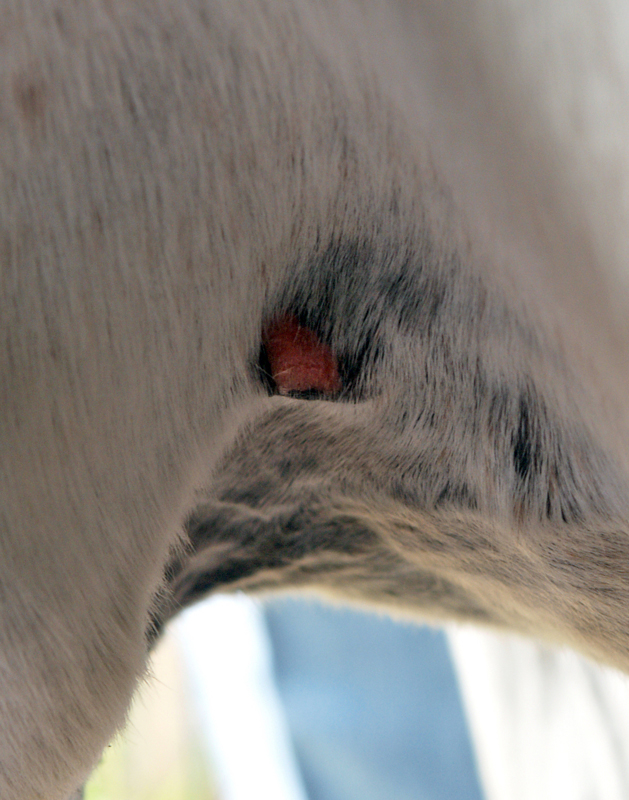
A significant cinch rub can result in the horse being laid off for several days, or longer – not a desirable option when you are riding out in the wilderness. Photo: Pam MacKenzie Photography
Rope Burns, Rubs, and Scalds
Trail riders who pack horses will likely face rope burns, rubs, and scalds more often than other riders simply because the horses are used over more challenging terrain and carry loads wrapped with ropes that may loosen and entangle. These loads are dead weight that rock and sway, and are far more likely than a rider to cause rubs, scalds, and blisters. Picket lines and hobbles may also cause rubs. Always use a soft cotton or nylon rope that is forgiving by nature and, when hobble training a horse, use a hobble that is wider than normal (18 to 20 inches).
Generally, rubs are not serious and are often not treated unless the skin is broken. However, if the horse has significant cinch rubs or hobble burn or a blister from a load, then you are faced with the possibility of being forced to retire the horse until it recovers, which is not a desirable option when you are two days out on a wilderness ride.
Rope burn and hobble rubs often occur in the pastern and fetlock or lower leg area and should always be treated with a good salve that sticks well, heals well, repels insects, and keeps the rubbed area supple. Repelling insects and keeping dirt out of the rub is key. We rarely bandage lower leg rubs on the trail because the wrappings just do not last on wilderness rides, and there is not much advantage to wrapping a rub unless it is a very aggressive rub with excessive bleeding and broken skin.
Saddle rubs in the wither area require careful attention. Increasing swelling in the wither area may indicate the presence of an infection or fistula, which can cause considerable damage to the bone structure of the vertebrae and even kill the horse.
Keep loads off of withers with blisters, rubs, or swelling until the swelling has gone down, and figure out what caused the problem in the first place. In other words, do not place an ill-fitting saddle back on that horse.
If we discover a rub when we remove a saddle, we usually pour cold water over the area, or apply cold packs to reduce the heat associated with bruising. Then we apply an antiseptic salve. If swelling continues to the point of infection we administer penicillin immediately, lance the lower edge of the infected area, allow it to drain, and get penicillin and Betadine® right into the infection. This is usually a job for a vet, but if you are on the trail and several days from being able to access a vet, not treating the horse is not an option. The point here is do not take a saddle sore or rub on the withers lightly.
The Flu
Influenza is as common in horses as in humans, and symptoms of equine influenza are similar to those of the human flu, usually including a fever and clear, leaky discharge from the nose. After several days the discharge may turn cloudy and a cough may develop. The horse will generally experience depression, loss of appetite, and may drink less.
Treatment for horses with the flu is much the same as for humans, excluding Gramma’s chicken noodle soup. This treatment generally consists of allowing the flu to run its course (which usually takes about one to two weeks). Bute can be effective in reducing the aches and pains associated with the flu.
If your horse comes down with the flu on the trail, it is important to take the horse to a sheltered area and allow it to rest. Even on remote trips we give a horse immediate time off if he has a leaky nose, cough, and depressed demeanour.
Here’s hoping you and your horse never need to know what you just learned! Enjoy the spring season and scratch those itchy feet with your stirrups!
The first aid information in this article is for information purposes only and should not be relied upon as a substitute for professional veterinary and/or medical advice. No liability will accrue to the publisher or author of the article in the event that a user suffers loss as a result of reliance upon the information.
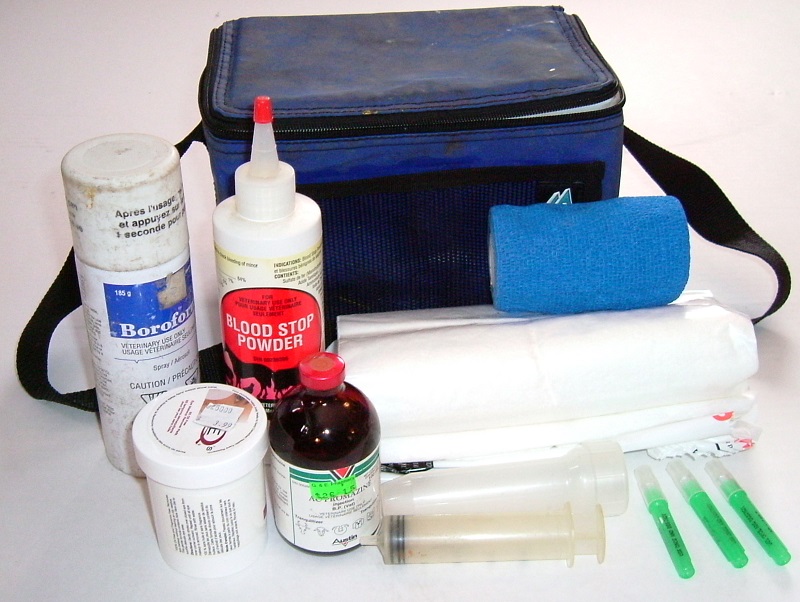
Photo: Stan Walchuk, Jr.
First Aid Kit for the Trail
We only carry one first aid kit on the trail, with all of the supplies needed to treat horses and humans. Here’s what we travel with during our overnight trips:
1. Bandage wraps are used to secure gauze, protect wounds, and provide support. Stretchy and self-sticking wraps, like CoFlex, Powerflex and Vetrap are best, but any off-the-shelf wrap will do.
2. Sterile gauze in roll and section form in various sizes protects wounds and can be used to create pressure points.
3. Tape has a host of uses including securing bandages. I suggest packing a couple rolls of electrical tape. Duct tape does not stretch and can seriously inhibit circulation if you use it as a wound wrap.
4. Scissors are handy for cutting gauze and tape, but many trail riders who have a sharp knife will pass on the scissors.
5. Hemostats are great for cleaning debris from wounds, but again, many trail riders travel with a Leatherman with pliers and would pass on a hemostat.
6. Disinfectants such as Betadine® or Hibitane® can be used to clean wounds and punctures.
7. A good topical salve or spray will repel contaminants and bugs, and initiate healing. We do not use a topical if it doesn’t repel bugs and we expect it to stick to the wound or rub for at least a day.
8. Wearing disposable gloves is a good idea when cleaning wounds and applying salves, not only to protect the horse from contaminants, but to protect you from harmful bacteria.
9. A thermometer can be used to monitor a horse’s temperature, but on the trail we often go by touch and pulse rates to determine a horse’s stress level.
10. On longer trips we take penicillin and sterile needles, and know how to administer it. We choose a penicillin that also has an anti-inflammatory and, if possible, an antihistamine.
11. Good bug dope is critical on our trips as it keeps bugs that can spread disease off our horses and out of their wounds. Bugs can also agitate horses and provoke them into doing something foolish. Our bug dope has to stick well; we have no use for bug dope that is ineffective a few hours after being applied, regardless of what the label says.
12. We used to carry Blood Stop Powder as it does help stop the flow of blood from wounds, but some feel that the granulation causes proud flesh.
You do not need to go overboard on quantity as it is very rare to have more than one major first aid event on a trip. If you do not have all of the items recommended, then use what you have – use water or salt water for flushing and cleaning wounds, apply personal ointment like Polysporin® as a topical, and cut strips of clothing for bandage wraps and gauze, etc.
To read more by Stan Walchuk on this site, click here.






